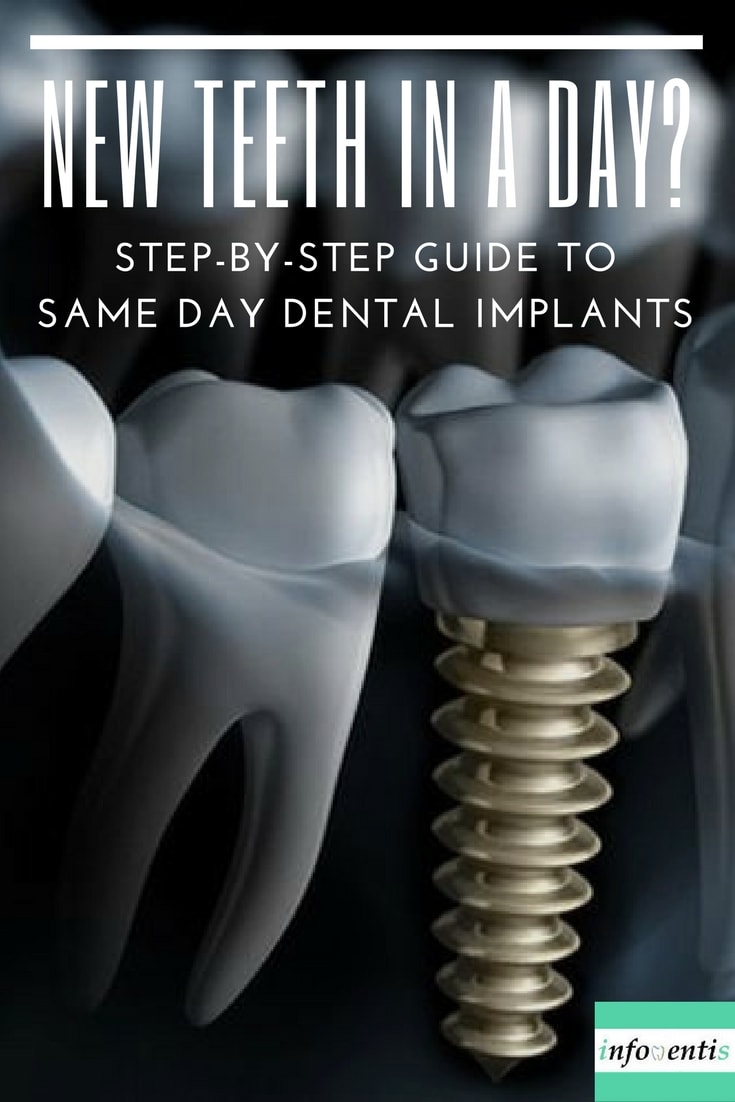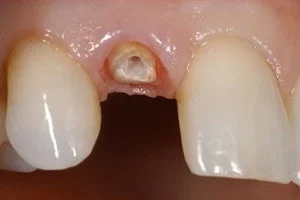
Same day dental implants
Dental implants have many benefits. One of the most important is replacing a broken or damaged tooth in the front area that can no longer be restored.

broken front tooth that can no longer be restored
In this case, an implant crown offers a highly aesthetic and efficient solution as it avoids the need to prepare the adjacent teeth.

after tooth removal, a dental implant is placed to restore the gap
However, the traditional procedure can take up to one year as it implies three different steps:
-
Removal of the existing tooth or root; the extraction socket is left to heal for four to six months before a dental implant is placed. During this period, the body will grow new bone inside the socket.
-
The implant is surgically inserted into the jaw bone. A variable healing time is required for osseointegration (3 to 6 months). Osseointegration is a biological process where the implant forms an intimate bond to the bone.
-
After the healing time, a dental crown is attached to the implant.
Teeth in a day: Immediate placement and loading
Patient demand for immediate gratification has increased; as a result, implant dentistry has since responded with immediate implant placement after extraction, followed by immediate loading of the crown.
Immediate loading is becoming far more common: the implant and temporary crown are placed within 48 hours of implant surgery and left in position for the healing period.
Who is a candidate for immediate tooth replacement with implants?
Immediate placement is not appropriate for all patients and cases, and the screening process should be comprehensive.
The ideal candidate is someone who is in good dental and general health. Some factors can also negatively affect dental implants:
- smoking
- any conditions that affect the immune system or reduce the body’s ability to heal
- some drugs, such as bisphosphonates, as these drugs increase the risk of bone death after surgery
- bruxism or teeth grinding and clenching
Patients who choose this approach must be committed to good oral hygiene. Furthermore, not overloading the implant crown is another factor that needs to be reinforced when loading an implant immediately after placement.
Patients with enough bone quantity and quality are great candidates for immediate placement and loading because of anticipated implant initial stability, assuming they would comply with postoperative instructions.
Procedure steps
There are a number of issues and steps to consider:
1. Consultation and planning
Dental implant surgery has to be meticulously planned; when you opt for immediate implant placement, careful planning and experience are prerequisites for success.
Your dentist will need to know your complete dental and medical history before carrying out various diagnostic tests, such as dental X-rays and a CT scan.
Your clinician will analyze the data from these tests to assess the quality of the bone that will be surrounding the dental implant.
When an implant is placed into a recent extraction site, many doctors prefer to graft bone in the alveolar socket to create a bony base for the implant.
There should also be enough gum tissue to surround the implant and crown, as this will affect aesthetics; the implant-crown should look like it is emerging naturally from the gums. Gingival tissue can be grafted from another site in the mouth if necessary.
At this stage, the dentist will also determine the best position for the implant and choose the correct size.
2. Removing the existing tooth
It is critical that your broken tooth is removed very carefully so that the tooth socket is not damaged.
If any bone from the walls of the socket is damaged or lost, it could lead to unsightly gum recession and a poor prognosis; in this case, many practitioners would prefer to end the procedure (and continue with the traditional approach) rather than risk a poor result.
3. Implant placement
When the same-day dental implant technique is used, your doctor will place the implant fixture in the bone right after the tooth extraction.
It is vital to place the implant in a stable and non-movable place in the bone. This stability is referred to as the primary stability of the implant.
The latest research suggests that the primary stability of the implant in bone is a more critical determinant of the success of implant integration rather than a certain period of healing time.
The tooth socket of an upper front tooth is cone-shaped. To achieve primary stability, the implant has to penetrate the apex of the socket (or the endpoint) and affix into the bone in this area (see image below).

Additionally, a bone graft can be placed inside the tooth socket.
Selecting the right-sized implant and ensuring it is placed in the correct position is essential.
4. Crown placement
The crown will be attached to the implant in one of two ways:
- Directly: the crown and the abutment are one piece, and a lag screw traverses both to secure the one-piece structure to the internal thread on the implant.
- Indirectly: first, the abutment is attached to the implant, and the crown will be cemented to the abutment. In this variation, the abutment can be used to create a change of angulation for the crown to emerge through the gum tissue with a more natural appearance.
Regardless of the variation, the newly attached crown must be free from biting forces, which could displace the implant. The crown is usually a temporary crown made of a composite or acrylic resin, which can easily be modified to ensure that it is both functional and cosmetic.
Once the implant is fully integrated with the bone, the temporary crown can be removed and replaced with a permanent one.
5. Care and maintenance
Immediate implant placement and loading require higher patient compliance. There are three key factors that patients have to consider:
-
Overloading
The implant restoration must be manageable as even micro-movement during the first two months of placement can result in non-fusion and failure of the implant to attach to the surrounding bone.
Avoid biting on extremely hard pieces of food, and contact your doctor if you notice any signs of involuntary teeth grinding and clenching.
-
Oral hygiene
To prevent infection, taking good care of the area around the implant for the first couple of months after the surgery is critical.
If maintaining this level of care could be a problem, then you should consider traditional dental implants that use a two-stage technique.
-
Smoking
You may not be suitable for this type of treatment if you are a heavy smoker and have problems quitting smoking and tobacco products.
Benefits and risks of same-day dental implants
a. Benefits
-
Reduced treatment time
A traditional implant can take six months to one year to completely restore, considering the tooth removal the starting point.
Same-day implants can replace a front tooth almost immediately.
-
Only one surgical procedure is required
Tooth removal, implant placement, and crown attachment are all performed during the same visit. Consequently, there is no need to uncover the implant 3-6 months later to attach the abutment and crown.
-
Better aesthetic results are achieved regarding the gum tissue
With immediate placement and loading, the temporary crown can shape the gum tissue. As a result, the gum tissue matches the permanent crown, and better aesthetic results are achieved.
-
It avoids the need for temporary dentures or the “missing teeth” look
Since the implant crown is attached in the same procedure, there is no need to wear a removable denture or have gaps in your smile during the healing period.
b. Risks and drawbacks
-
Even the slightest movement increases the risk of failure
Same-day implant placement is a very precise technique. The practitioner must take all necessary measures to ensure the implant cannot move while integrating with the bone, especially in the first two months.
-
The technique is only suitable for specific situations
As mentioned, same-day implants are not appropriate for all patients and cases, and the selection process is an essential step of this treatment.
-
The implant surgeon has to be skilled and experienced
Same-day implants cannot be performed by anyone. The surgeon must be skillful and experienced enough to place the dental implant accurately to eliminate the risk of micro-movements.
Conclusions
First, patients must understand the risks, benefits, and alternatives regarding single-tooth implant placement and timing. Same-day implants can only be used in specific situations, and patients need to be carefully evaluated for suitability.
Preplanning and experience from the implant surgeon, as well as thoroughly conducted care measures, are required for the success of this technique.
If you are not suitable for immediate dental implant placement, it is still worth considering delayed loading implants, even though treatment will take a little longer.
References
American Academy of Implant Dentistry: Dental Implants, Alternative Techniques
Dear Doctor, A Patient Education Company: Same-Day Tooth Replacement With Dental Implants
The National Center for Biotechnology Information: Role of primary stability for successful osseointegration of dental implants: Factors of influence and evaluation



